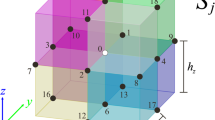Abstract
This paper studies the effect of heterogeneous tissue conductivity in a human head model for the EEG forward problem. Firstly, the tissue heterogeneity in conductivity was characterised from measured data in the literature. Then a method was developed to include this feature in modelling. Finally, the effect of tissue heterogeneity on EEG signals was studied. Based on these studies the paper concludes that the inclusion of tissue heterogeneity is significant in accurate head modelling for the EEG problem.
Similar content being viewed by others
References
Plonsey, R. & Fleming, D.,Bioelectric Phenomena, McGraw-Hill Book Company, New York, 1969.
Malmivuo, J. & R. Plonsey, R.,Bioelectromagnetism — Principles and Applications of Bioelectric and Biomagnetic Fields, Oxford University Press, New York, 1995.
Awada, J. A.et al, “Computational aspects of finite element modelling in EEG source localisation”,IEEE Trans. Biomed. Eng., Vol. 44, No. 8, pp. 736–752, 1997.
Cuffin, B. N., “EEG dipole source localisation: using inverse solution for determining source locations”,IEEE Engineering in Medicine and Biology, pp. 118–122, Sep./Oct., 1998.
Gutierrez, D. & Muravchik C. H., “Estimating brain conductivities and dipole source signal with EEG arrays,”IEEE Trans. Biomed. Eng., vol. 51, pp. 2113–2122, Dec. 2004.
Duck, F. A.,Physical Properties of Tissue: A Comprehensive Reference Book, Academic Press Limited, 24–28 Oval Road, London NW1 7DX, UK, 1990.
Oostendorp T. F., Delbeke J. & Stegeman, D. F., “The conductivity of the human skull: Results of in vivo and in vitro measurements,”IEEE Trans. Biomed. Eng., vol. 47, pp. 1487–1492, Nov. 2000.
Wen, P.,Human head modelling and computation for the EEG forward problem, PhD thesis, Flinders University of South Australia, Adelaide, Australia, 2001.
Ferree, T.C., Eriksen K. J. & Tucker, D. M., “Regional head tissue conductivity estimation for improved EEG analysis”,IEEE Trans. Biomed. Eng., Vol. 47, No. 12, pp. 1584–1593, 2000.
Meijs, J. W. H.et al, “The influence of various heads on EEG’s and MEG’s”, inFunctional Brain Imaging, Pfurtscheller, G. & Silva, F. H. L., Eds., Toronto, Canada: Huber, pp. 31–46, 1988.
Yan, Y., Nunez, P. L. & Hart, R. T., “Finite element model of the head: Scalp potentials due to dipole sources,”Med. Biol. Eng., Comp., Vol. 29, pp. 475–481, 1991.
Lemieux, A. M. & Hand, J. W., “Calculation of electrical potentials on the surface of a realistic head model by finite differences”,Phys. Med. Biol. Vol. 41, pp. 1079–1091, 1996.
Law, S. K., “Thickness and resistivity variations over the upper surface of the human skull”,Brain Topography, Vol. 6, No. 2, pp. 99–109, 1993.
Wen, P., He, F. B. & Sammut, K., “The heterogeneous conductivity property of cranial tissues and its representation in numerical head model”,Australasian physical & engineering sciences in medicine, Vol.22, No. 3, pp. 92–98, 1999.
Goncalves S., de Munck, J. C., Verbunt J. P. A., Bijma F., Heethaar R., & da Silva F. L., “In vivo measurement of brain and skull resistivities using an EIT based method and realistic models for the head,”IEEE Trans. Biomed. Eng., Vol. 50, No. 6, pp. 754–767, June. 2003.
Ary, J. P., Klein, S. A. & Fender, D. H., “Location of sources of evoked scalp potentials: Corrections for skull and scalp thickness”,IEEE Trans. Biomed. Eng., Vol. 28, No. 6, pp. 447–452, 1981.
Cuffin, B. N., “Effects of local variations in skull and scalp thickness on EEG’s and MEG’s,”IEEE Trans. Biomed. Eng., Vol. 40, pp. 42–48, 1993.
Eshel, Y., Witman, S., Rosenfeld, M. & Abboud, S, “Correlation between skull thickness asymmetry and scalp potential estimated by a numerical model of the head”,IEEE Trans. Biomed. Eng., Vol. 42, No. 3, pp. 242–249, 1995.
Haueisen, J,et al, “Influence of tissue resistivities on neuromagnetic fields and electric potentials studied with a finite element model of the head”,IEEE Trans. Biomed. Eng., Vol. 44, pp. 727–735, 1997.
Marin, G.et al, “Influence of skull anisotropy for the forward and inverse problem in EEG: simulation studies using FEM on realistic head models”,Human Brain Mapping, Vol. 6, pp. 250–269, 1998.
Author information
Authors and Affiliations
Corresponding author
Rights and permissions
About this article
Cite this article
Wen, P., Li, Y. EEG human head modelling based on heterogeneous tissue conductivity. Australas. Phys. Eng. Sci. Med. 29, 235–240 (2006). https://doi.org/10.1007/BF03178571
Received:
Accepted:
Issue Date:
DOI: https://doi.org/10.1007/BF03178571




